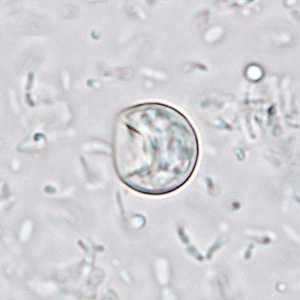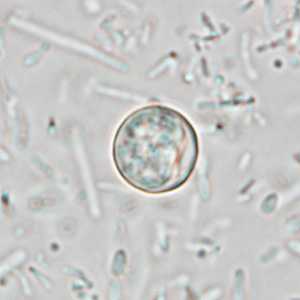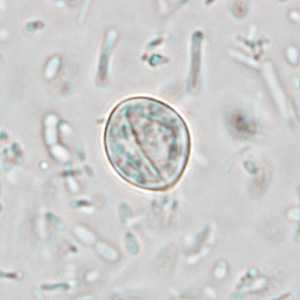
Case #233 - August, 2008
A 37-year-old man began experiencing severe diarrhea about one week after attending a family social event. At the request of his medical provider, a fecal specimen collected in the two-vial system consisting of one vial with 10% formalin and one vial with Zn-PVA (zinc-based polyvinyl alcohol) was submitted for examination. An FEA concentration procedure and wet mount examination was done on the formalin preserved specimen. Figures A–C shows structures that were found in moderate numbers at 1000x magnification. The structures measured about 8-10 micrometers in diameter. A smear was made from the specimen preserved with PVA and stained using trichrome. Figures D and E show similar round objects that were observed. What is your diagnosis? Based on what criteria? What other testing methods would you suggest?

Figure A

Figure B

Figure C

Figure D

Figure E
Case Answer
This was a case of cyclosporiasis caused by Cyclospora sp., most-likely C. cayetanensis. Diagnostic features were:
- the size of the round objects, which was consistent with Cyclospora spp. (8-10 micrometers).
- the morphological appearance of the objects was wrinkled or ‘cracked glass-like.’

Figure A

Figure B

Figure E

Figure F
To confirm the presence of Cyclospora spp., it is recommended that an acid-fast stained smear be performed and examined and/or a wet mount prepared and examined using UV fluorescence microscopy. Figures A, C, E, and F show the same oocysts using brightfield and UV fluorescence microscopy, respectively.
More on: Cyclosporiasis
Images presented in the monthly case studies are from specimens submitted for diagnosis or archiving. On rare occasions, clinical histories given may be partly fictitious.
DPDx is an education resource designed for health professionals and laboratory scientists. For an overview including prevention and control visit www.cdc.gov/parasites/.
- Page last reviewed: August 24, 2016
- Page last updated: August 24, 2016
- Content source:
- Global Health – Division of Parasitic Diseases and Malaria
- Notice: Linking to a non-federal site does not constitute an endorsement by HHS, CDC or any of its employees of the sponsors or the information and products presented on the site.
- Maintained By:


 ShareCompartir
ShareCompartir